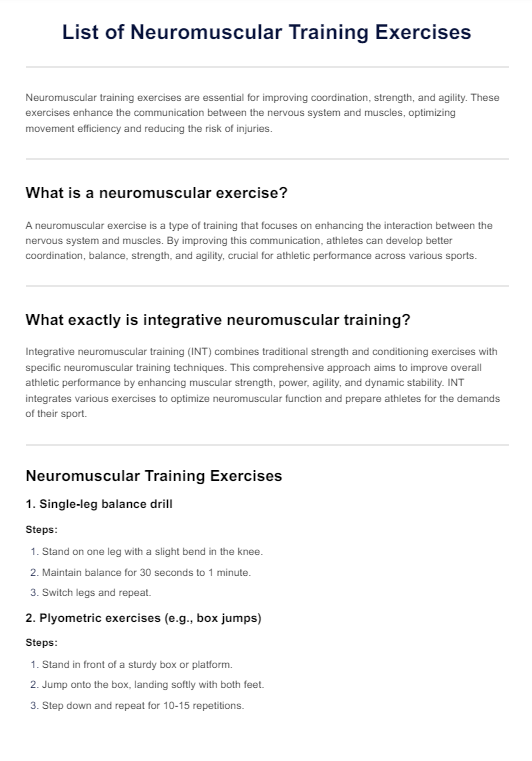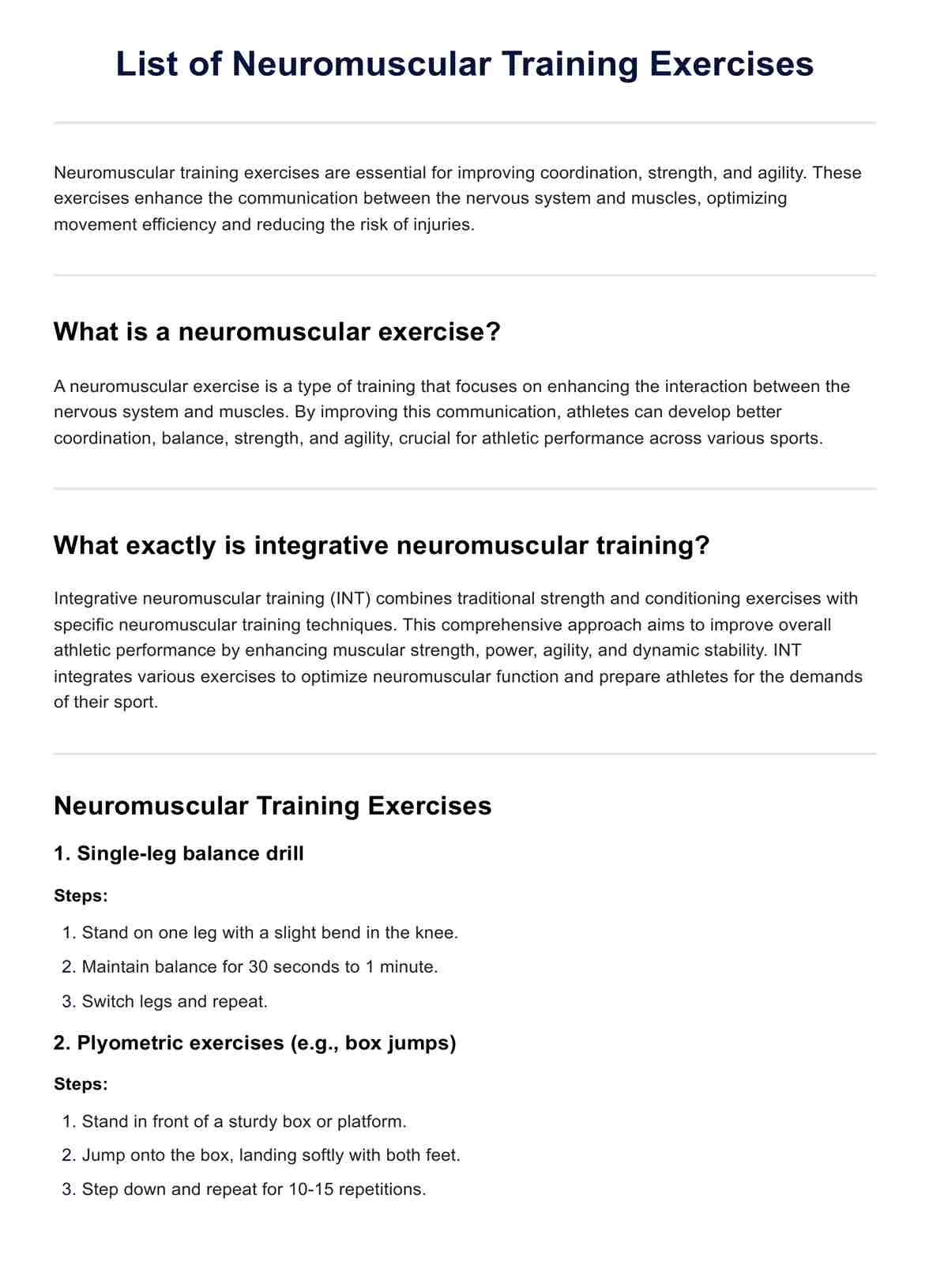List of Neuromuscular Training Exercises
Explore a comprehensive List of Neuromuscular Training Exercises with examples and download Carepatron's free PDF guide to enhance your workouts and maximize performance.


What is a neuromuscular exercise?
Neuromuscular exercises are specialized training routines designed to enhance the communication between the nervous system and the muscles, optimizing the body's movement efficiency. These exercises are a crucial component of neuromuscular training programs, which aim to improve strength, balance, coordination, and agility. Neuromuscular training involves a combination of resistance training and dynamic movements, focusing on the body's ability to perform complex, sport-specific actions with precision and control.
Accepted academic practice highlights the importance of neuromuscular training for young and adolescent athletes, emphasizing its role in injury prevention. These training programs are especially beneficial for young athletes, as they lay the foundation for long-term athletic development and performance enhancement.
A typical neuromuscular training program includes various exercises such as plyometrics, balance drills, and resistance training, all designed to enhance the neuromuscular system's responsiveness and efficiency. Strength training is also a key component, as it helps build muscle endurance and power. The focus of neuromuscular training is on creating a well-rounded athlete capable of handling the physical demands of their sport while minimizing the risk of injury.
What exactly is integrative neuromuscular training?
Integrative neuromuscular training focuses on combining traditional strength and conditioning exercises with specific neuromuscular training exercises. The goal of INT is to enhance both physical and neuromuscular development, optimizing overall athletic performance and reducing the risk of injuries. This approach integrates elements such as strength training, balance exercises, plyometrics, and agility drills into a cohesive training program.
This method is particularly beneficial for young and adolescent athletes, as it supports their growth and development while teaching them essential motor skills. This integrative approach ensures that athletes build a solid foundation for long-term athletic success and overall physical health.
List of Neuromuscular Training Exercises Template
List of Neuromuscular Training Exercises Example
Benefits of neuromuscular exercises
Neuromuscular exercises offer numerous advantages that are essential for athletic development and prevent injury. These benefits are well-documented in sports medicine and supported by systematic reviews. Here are five key benefits of incorporating neuromuscular exercises into training programs.
Enhanced strength and power
Neuromuscular exercises, combined with strength training, significantly improve muscle strength and power. This is particularly beneficial for youth athletes, helping them build a solid foundation for their athletic performance. Exercises like squats and lunges develop muscle endurance and explosive power.
Improved balance and coordination
Balance training is a crucial component of neuromuscular exercises. It enhances an athlete's ability to maintain stability during dynamic movements. This is especially important for female adolescent athletes, who benefit greatly from improved balance and coordination, reducing their risk of injuries.
Increased agility and speed
Agility training, including plyometric training, enhances an athlete's ability to change direction quickly and efficiently. Neuromuscular exercises that focus on agility improve overall athletic performance and are vital for young athletes looking to excel in sports that require quick, precise movements.
Better dynamic stability
This refers to maintaining control of the body's movements during activity. Neuromuscular exercise improves this aspect by strengthening the core and enhancing neuromuscular control. This benefit is critical for athletes in all sports, ensuring they can perform movements safely and effectively.
Injury prevention
A systematic review of sports med literature highlights the role of neuromuscular exercises in prevent injury. These exercises improve muscle strength, balance, and coordination, which are key factors in reducing the risk of injuries, particularly in female adolescent athletes and other youth athletes. Incorporating these exercises into training programs is a proactive approach to safeguarding athlete health.
How to train the neuromuscular system
Training the neuromuscular system is essential for enhancing sports performance and reducing injury risks. By following a structured approach, athletes can improve their muscle fitness and neuromuscular control, contributing to their long-term athlete development. Here are the key steps to effectively train the neuromuscular system.
Start with fundamental movements
Begin by mastering movements such as squats, lunges, and push-ups. These exercises form the basis of neuromuscular training and help in developing proper form. Emphasizing body weight exercises initially ensures that athletes build a solid foundation of strength and stability.
Incorporate agility exercises
Agility exercises are crucial for enhancing the body's ability to change direction quickly and efficiently. Drills such as ladder drills, cone drills, and shuttle runs improve coordination and reaction time, which are vital for performance in sports. These exercises also enhance the athlete's ability to maintain control during dynamic movements.
Focus on balance and stability
Balance training is essential for developing neuromuscular control, particularly around the knee joint. Exercises like single-leg stands and stability ball exercises enhance dynamic stability and proprioception. This focus is especially important for preventing injuries to the anterior cruciate ligament (ACL), which is critical for athletes.
Implement plyometric training
Plyometric training involves explosive movements like box jumps and bounding. These exercises improve muscular fitness and power, contributing to better sports performance. Focusing on explosive strength helps develop the fast-twitch muscle fibers necessary for high-intensity activities.
Examples of neuromuscular training programs
Neuromuscular training programs are tailored regimens designed to enhance athletic performance by targeting specific aspects of neuromuscular function. Here are three examples of effective neuromuscular training programs:
ACL injury prevention program
This program focuses on exercises that strengthen muscles around the knee joint and improve neuromuscular control to reduce the risk of anterior cruciate ligament (ACL) injuries. It includes exercises such as single-leg squats, lateral lunges, and balance drills. Emphasis is placed on proper landing techniques and dynamic stability to protect the knee during sports movements.
Plyometric training program
Plyometric training programs aim to enhance explosive power and agility through rapid, powerful movements. Exercises include box jumps, depth jumps, and lateral bounds. These drills improve fast-twitch muscle fiber recruitment and proprioceptive awareness, essential for athletes in sports requiring quick changes in direction and speed.
Youth athlete development program
This program is designed for young athletes to develop fundamental movement skills and neuromuscular coordination. It includes bodyweight exercises like squats, lunges, and push-ups to build foundational strength and stability. Agility drills, balance exercises, and coordination activities are integrated to enhance overall athletic performance and prepare youth athletes for sport-specific skills.
Each of these neuromuscular training programs is structured to address specific aspects of athletic performance and injury prevention.
Is resistance training needed for the neuromuscular system?
Resistance training plays a crucial role in enhancing the neuromuscular system across different stages of athlete development and in daily living. It involves exercises that utilize external resistance, such as weights or resistance bands, to stimulate muscle growth and strength gains. Specifically, resistance training improves muscular strength, endurance, and core stability, which are essential for protecting the knee joint and preventing ACL injuries in athletes across various sports.
Commonly asked questions
A neuromuscular exercise is a type of training that enhances communication between the nervous system and muscles, improving coordination and movement efficiency.
The 5 neuromuscular skills include strength, power, agility, balance, and coordination.
An example of neuromuscular activity is performing plyometric exercises like jump squats or box jumps, which involve explosive movements to improve muscle power and coordination.







































































































